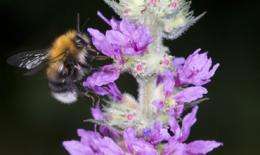Bumblebee re-introduced to UK

This month, a campaign was launched to re-introduce the short-haired bumblebee to the UK from New Zealand.
This species, Bombus subterraneus, was last recorded in the UK in 1988. Luckily a small number of British bees were transported to New Zealand in the late 19th century to pollinate crops of red clover.
The short-haired bumblebee project is set up by Natural England, the Bumblebee Conservation Trust (BBCT), RSPB and Hymettus. It hopes to restore suitable bumblebee habitat in England, with the help of farmers, to bring back the British bees and protect them in the future.
Declining numbers
Some bumblebees are under threat worldwide and some UK species are declining in numbers. This seems to be due to habitat loss and loss of certain flower species such as the red clover.
Bees worldwide
The UK has around 20 bumblebee species and there are about 250 bumblebee species worldwide. However, there are about 20,000 different bees around the world and this includes bumblebees, honeybees and solitary bees.
Important pollinators
Many bees are extremely important for pollinating commercial crops such as cucumbers, tomatoes, strawberries and coffee. Bees account for 85% of the value of all insect pollinated crop plants in Europe.
Bumblebees in the Museum garden
It may be surprising to know that 8 of the 20 British species have been seen buzzing around in the heart of London in the Natural History Museum's Wildlife Garden.
The garden habitat is a haven for the insects and attracts all of the 6 common bumblebee species (the common carder, red-tailed, early-nesting, white-tailed, buff-tailed and garden) as well as the less common tree bumblebee, southern cuckoo bumblebee, and four-coloured cuckoo bumblebee.
New bumblebee arrival
The tree bumblebee, Bombus hypnorum, was a surprise arrival into the Museum garden in 2006. Colonising southern England only recently, probably from France, it has reached Yorkshire after only 8 years.
It has a gingery front and black tail with a contrasting white tip. The males regularly visit plants such as the greater willow herb, purple loosestrife, teasel and buddleja. Tree holes and sometimes bird boxes are favourite nesting sites.
Lookalikes
A number of other insects in the Wildlife Garden look like bumblebees, such as chunky black and brown flower bees Anthophora spp., which can be seen darting from flower to flower. They are easy to spot because they fly much faster than the leisurely bumblebees.
A number of hoverflies are bee mimics, such as Eristalis intricarius. Their black, yellow and white stripes earn them some protection from predators.
Source: The Natural History Museum












